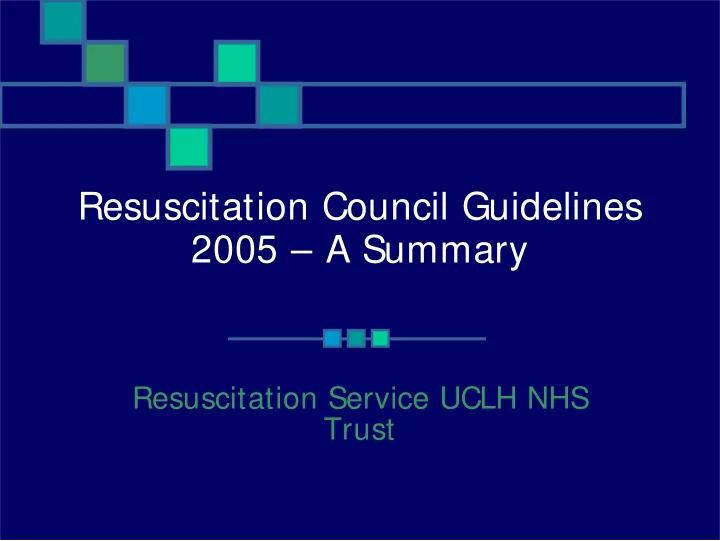

Resuscitation Council Guidelines 2005 – A Summary Resuscitation Service UCLH NHS Trust
Objectives � To present the Adult Resuscitation Council Guidelines 2005 to clinical staff at UCLH NHS Trust
In Hospital Basic Life Support � New recommendations are to start BLS if pt is unresponsive and not breathing properly (no pulse check) � Agonal Breathing is a sign of Cardiac Arrest � 30 Chest Compressions FI RST then 2 Ventilations � Hand Position – Middle of the Lower half of the sternum � Inspiratory time of 1 second instead of 2 secs
Assess Rhythm VF/VT Defibrillate X 1 Ventricular Fibrillation/ 150J Biphasic Pulseless Ventricular Tachycardia Immediately resume CPR 2 min
VF/VT Check rhythm Adrenaline 1mg IV only Shock 150J* Shock 150 J* Immediately resume Immediately resume 2 mins CPR 2 mins CPR Check rhythm Check rhythm Amiodarone 300mg IV only Shock 150 J* Shock 150 J* Immediately resume 2 mins CPR Immediately resume 2 mins CPR If Monophasic Must be at 360J
During CPR: Correct reversible causes � check electrode position and contact � � attempt / verify: IV access Airway & Oxygen Give uninterrupted compressions if airway secure � Give adrenaline every 3-5 min � Consider: Amiodarone, magnesium, atropine � Drug-Shock-CPR-rhythm check
Potential reversible causes: • Hypoxia • Hypovolaemia • Hypo/hyperkalaemia/metabolic • Hypothermia • Tension pneumothorax • Tamponade, cardiac • Toxins • Thrombosis (Coronary or Pulmonary)
Assess Rhythm Non-VF/VT Asystole Pulseless Electrical Immediately resume Activity (PEA) CPR 30 : 2 2 min
Asystole and Slow PEA ( rate< 60 min - 1 ) CPR 30:2 whilst checking leads attached Give 1 mg Adrenaline and 3 mg Atropine (once only) Check Rhythm CPR 30:2 (Continuous if Airway secured)
Pulseless Electrical Activity CPR 30:2 whilst checking leads attached Give 1 mg Adrenaline Check Rhythm CPR 30:2 (Continuous if Airway secured)
Post Arrest care � Ensure ventilation rate is appropriate not excessive eg approx 10 per minute. � Unconscious adult patients with spontaneous circulation after out-of-hospital VF arrest should be cooled to 32 – 34 °C for 12 – 24 hours � Mild Hypothermia may benefit those with circulation after out-of-hospital cardiac arrest from non-shockable rhythm or after in hospital cardiac arrest
Death By Hyperventilation?
More information http://www.resus.org.uk/pages/guide.htm Or ERC website
Recommend
More recommend